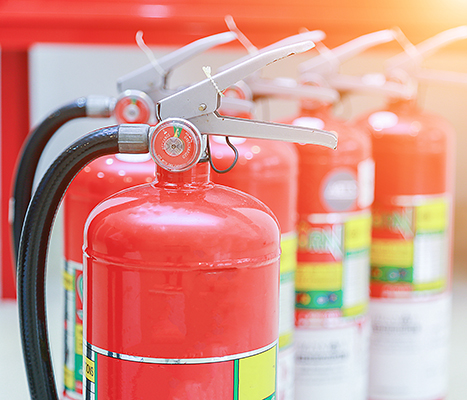Blog
Keep calm and pick up the correct extinguisher

At work, at home or in the car, fire extinguishers are one of the most effective manual devices for controlling or extinguishing fires. Use them correctly and you will prevent damage and save lives. But would you know which fire extinguisher to wield when things heat up?
Let’s look at the most common extinguishers you are likely to encounter.
Isn’t all fire the same?
The short answer – No. Fires vary enormously. As such, fire extinguishers are tailored to tackle different blazes in different ways. Understanding the differences between types of fire is vital for knowing how to fight them. Read more about fire classification here.
When it comes to safeguarding your property, the variety of fire extinguishers on offer can become confusing. To help, here are some standard types you should be considering…
Water
Water-based fire extinguishers diminish the heat element of the fire triangle, rapidly cooling the fire. These extinguishers are for Class A (wood, paper, plastic, etc.) fires only – they should not be used on Class B (flammable liquids and gases) or Class K (grease and fat) fires as the water will simply spread the flames, nor should water be used on Class C fires where electrical equipment could cause electrocution.
Foam
Best used on fires involving solids and flammable liquids, foam extinguishers work by separating the elements of the fire. The foaming agent can sit/float on top of the burning material, breaking the interaction between the flames and the fuel surface.
Carbon Dioxide
Carbon Dioxide (CO2) fire extinguishers suffocate fires by displacing the oxygen around the fire, as well as helping to cool the blaze. This makes CO2 extinguishers perfect for fighting Class B and Class C fires, though they are less effective on Class A. Be careful, however, as Carbon Dioxide extinguishers are unsuitable for use in small rooms with poor ventilation, due to the risk of asphyxiation.
Dry Powder
Dry Powder extinguishers should be included in your fire-fighting arsenal where there is risk of a Class D fire (involving combustible metals) in your property. When used on burning metals, the powder coats the metal therefore preventing interaction with the surrounding oxygen. These extinguishers are relatively ineffective against all other classes of fires. You are more likely to encounter this type of fire extinguisher at work than at home.
Wet Chemical
Wet Chemical is a new agent that firstly works by lowering the temperature of the fire with a cool mist. Similar to the Foam extinguisher, the Wet Chemical also prevents re-ignition by forming a barrier between the fuel and oxygen elements. Wet Chemical extinguishers are perfect for use against Class K fires.
Advice and guidance
At TransPro Systems we recognise the best ways to prevent damage and protect lives when it comes to fire emergencies. If you are unsure about the type of fire extinguisher you require then get in touch with one of our specialists. Peace of mind is just a conversation away.
